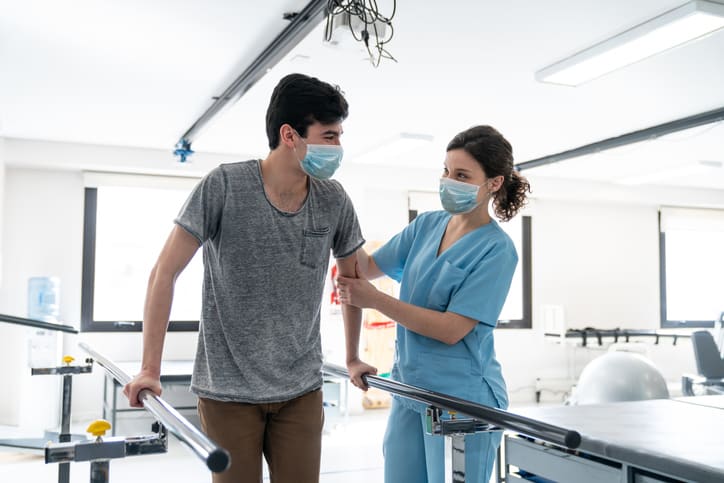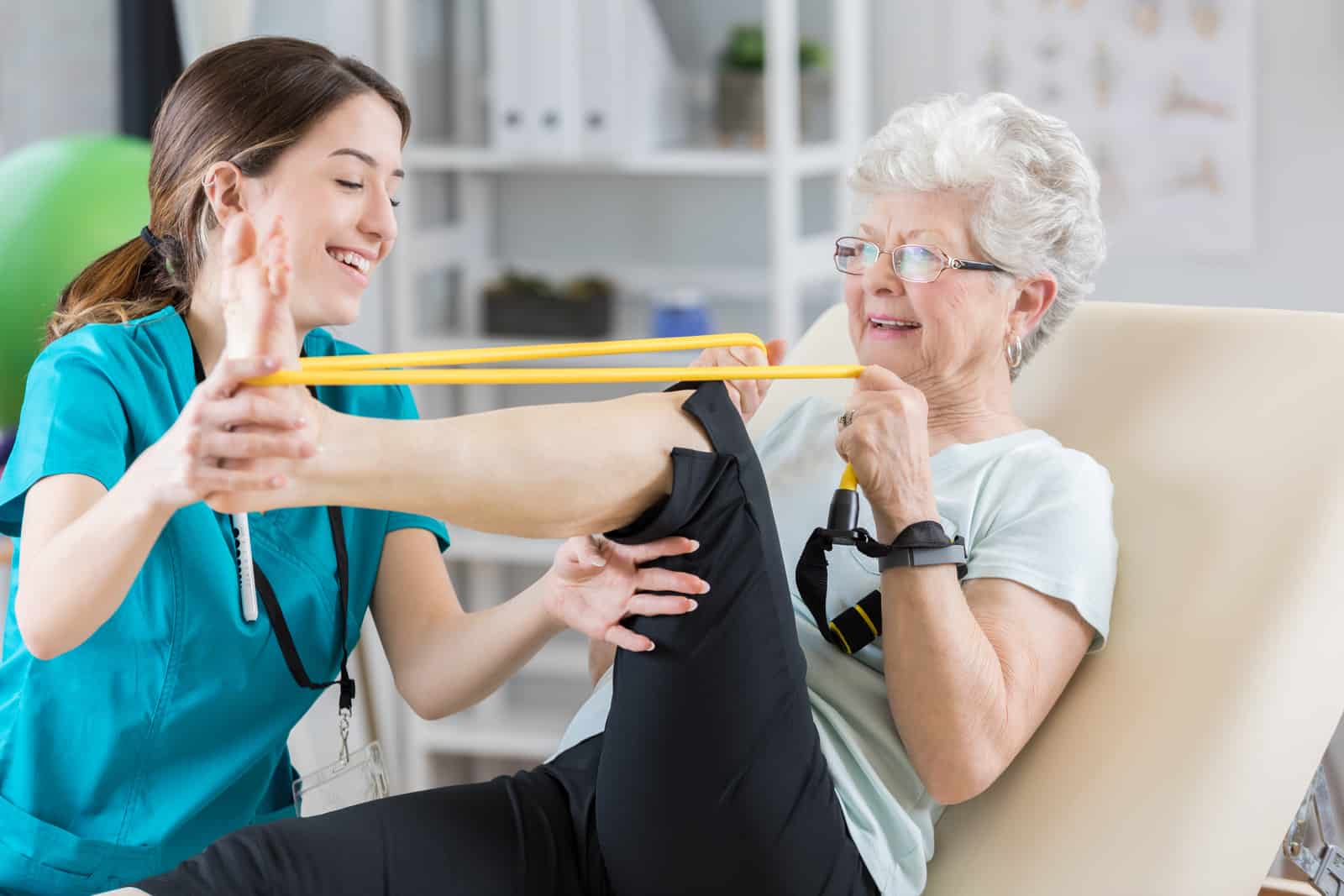
Covid-19 has made 2020 a challenging year (to say the least!).
All of a sudden things were changing at a fast and furious pace. From wearing masks to new policies and procedures and implementation of telehealth the healthcare industry has been through a lot this year. One of the things we have needed to consider is how COVID-19 will impact survivors. While we don’t yet know everything about the long-term effects of this virus, we are learning more and more as the months go on.
Recently an article was published on Pelvic Floor Considerations in COVID-19.1 The authors reported that much of the research and clinical commentary on COVID-19 have been focused on respiratory function. Pelvic floor therapists understand that both respiratory dysfunction and hospitalization can have an impact on pelvic floor function. They discussed in a commentary context as to how the long-term effects of COVID-19 could affect the pelvic floor as well as some generalized treatment considerations. They concluded that because of the pervasive nature of this virus, pelvic floor physical therapists should be a part of the rehabilitation team treating these patients once they have become medically stable.
Some people may wonder how a physical therapist who specializes in -pelvic rehabilitation fits into the treatment team for this population. The authors discuss that one of the more complicated aspects of COVID-19 is that it has the potential to affect every system of the body to varying degrees. There has been an abundance of information extolling the lingering issues with the respiratory system after surviving COVID-19, but, to date, the other physiologic complications have not been widely discussed. Because of the COVID-19 virus using the angiotensin-converting enzyme 2 (ACE2) as a host cell receptor, the virus can negatively impact the digestive system and the bladder in addition to the respiratory system.2 These receptor cells live not only in the nasopharynx and the lungs but also in the small bowel, creating multiple digestive implications for patients long after they have survived the initial infection. The following examples are more conditions that might affect disease severity versus considerations for treatment. For example, patients with Crohn’s disease or irritable bowel disease might be at a greater risk for infection if they are taking immunosuppressant therapy; however, the medication may have a protective effect against the unmediated immune response thought to be responsible for severe disease presentation. Research suggests that since estrogen enhances T-cell production at certain points in the hormonal cycle, there may be protective effects for women who are currently menstruating or taking synthetic hormones.3 The unpredictable nature and novel side effects of this virus can make it difficult for therapists across the continuum of care to use traditional treatment methods that we have used for similar problems in the past. It is important that we consider using our extensive knowledge of anatomy and physiology as well as illness recovery principles to adapt our typical treatment ideas to this special population. Most physical therapists may not be used to dealing with patients who have had this level of illness, especially if they work in a traditional outpatient setting. However, because of the pervasive nature of this virus, physical therapists should be a part of the rehabilitation team treating these patients once they have become medically stable.
At this point in time we do not yet know what effects the COVID-19 virus has on the pelvic floor muscles (levator ani, coccygeus, and obturator internus). However, we can begin to predict potential issues by understanding the relationship between pulmonary and pelvic floor functions. The authors state that in healthy individuals, respiration is characterized by the exchange of oxygen and carbon dioxide between the air within the lungs and the vascular system. During inspiration, the respiratory diaphragm contracts and flattens and the chest wall expands. This creates negative pressure in the thorax, drawing air deep into the lungs. During typical inhalation, the descent of the diaphragm also causes expansion of the abdominal wall and the pelvic floor, due to an increase in abdominal pressure. During quiet breathing, exhalation consists of a passive expulsion of air from the lungs, as the diaphragm recoils to its resting position. With quiet expiration, the abdominal wall and pelvic floor will gently contract to return to their resting position. With times of increased respiratory demand, active exhalation can increase the efficiency of air expulsion to accelerate gas exchange. During active exhalation, accessory muscles of respiration contract to speed up the elevation of the diaphragm. The pelvic floor and abdominals are included within these accessory muscles because when they co-contract more forcefully than in quiet breathing, they create a cranially directed increase in intra-abdominal pressure that assists with diaphragm elevation.4
At this time, we know that the SARS-CoV-2 virus attacks host cells via binding to ACE2 receptors. These receptors are largely present in the lungs, cardiovascular system, ileum, kidney, and bladder. Transmission via aerosolized droplets makes initial infection of pulmonary cells the most common. Once infected, the host’s immune system launches an accelerated immune response that causes an inflammatory cascade that has the potential to not just attack the virus but also cause damage to host cells. Within the lungs, this uncontrolled inflammatory cascade is thought to be responsible for the progression of disease from mild-moderate (80% of infections) to severe-critical (20% of infections). Mild to moderate disease presents similarly to an upper respiratory tract infection and can cause mild pneumonia. Restrictive lung disease decreases volume of inspiration due to scarring, preventing full expansion of the lungs. Limited diaphragm excursion and shortness of breath with low levels of exertion are common.5 Considering this normal relationship of diaphragm descent and pelvic floor lengthening and diaphragm elevation and pelvic floor contraction, when a disease process impacts the respiratory system, we may also expect to see pelvic floor dysfunction.
Clinically we need to be aware of this relationship in order to apply evaluation and treatment appropriately. Currently there is no evidence to guide the formation of a clinical hypothesis and treatment, therefore we need to theorize what might be expected on the basis of existing evidence on related lung pathologies and the relationship of pelvic floor and diaphragm.
The article explores the contribution of respiratory dysfunction to the underactive pelvic floor, the overactive pelvic floor, and their associated symptoms.
An underactive pelvic floor is characterized by an inability to meet the demands of maintaining continence or pelvic organ support due to deficits in power, endurance, or correctly timed coordination of contraction. The residual respiratory symptoms of COVID-19, including coughing and shortness of breath, might contribute to pelvic floor underactivity and cause new or worsening urinary or fecal incontinence and/or pelvic organ prolapse. Populations that have increased incidence of chronic coughing have a higher incidence of urinary incontinence, fecal incontinence, and pelvic organ prolapse. The theorized mechanism is repetitive microtrauma to the pelvic floor from frequent, high levels of intra-abdominal pressure associated with coughing.6 We might also expect the repetitive coughing associated with COVID-19 might cause the same dysfunction.
An overactive pelvic floor is characterized by an inability to fully relax and lengthen.
The residual effects of COVID-19 that might contribute to an overactive pelvic floor are restricted diaphragm excursion or due to development of pulmonary fibrosis or possible restrictions in chest wall mobility from prolonged positioning. Also, worth briefly mentioning, anxiety is common in people with shortness of breath and has been associated with pelvic pain.7 When treating the COVID-19 survivor with an overactive pelvic floor, therapists should incorporate sympathetic down training techniques along with traditional manual therapy and exercise to allow for further eccentric control of the muscle and proprioceptive awareness.
It is important to note that this patient population may experience many issues at once, making pelvic rehabilitation more challenging. Some patients may have cognitive decline, proximal weakness issues, anxiety, or other problems being infected that will need to be taken into consideration when developing their program.
The article states that even if physical therapists are not getting these patients referred directly to them, it is important for them to be aware of these bowel and bladder side effects and to work with our colleagues across the continuum of care to screen for deficits in these systems. We are aware of the impact that bowel, bladder, and sexual dysfunction has on the quality of life at any point along the disease process. But in the attempt to rehabilitate these neuromuscular deficits, the focus on overall physical recovery may cause us to neglect to ask questions about systems other than the musculoskeletal system and therefore miss the opportunity to identify life-altering problems in COVID-19 patients. By collaborating with our colleagues in the neurologic, orthopedic, and home health settings about screening questions of bowel and bladder function for these patients, pelvic floor physical therapy may be able to provide an improvement of functioning in a variety of quality-of-life domains and metrics. A simple 5-question screening tool may help pick up on bowel and bladder concerns in the general rehabilitation population:
- Are you experiencing any urinary incontinence?
- Are you able to delay urination if you have the urge? If so, for how long?
- Are you experiencing any constipation?
- Are you experiencing any fecal incontinence?
- Are you experiencing any pain in the pelvic or abdominal region?
If the patient answers yes to any of these questions, it may be appropriate to at least refer to a pelvic floor physical therapist for an educational consultation.
As we learn more about this virus and its long-term implications, we should see updated research guidelines. Clinicians are encouraged to watch for these changes in order to offer the highest level of care to their patients who are recovering from this infection.
References
- Siracusa, Carina PT, DPT; Gray, Amelia PT, DPT Pelvic Floor Considerations in COVID-19, Journal of Women’s Health Physical Therapy: October/December 2020 – Volume 44 – Issue 4 – p 144-151 doi: 10.1097/JWH.0000000000000180
- Li M-Y, Li L, Zhang Y, Wang X-S. Expression of the SARS-CoV-2 cell receptor gene ace2 in a wide variety of human tissues. Infect Dis Poverty. 2020;9(1):45. doi:10.1186/s40249-020-00662-x.
- Breithaupt-Faloppa AC, Correia CJ, Prado CM, Stilhano RS, Ureshino RP, Moreira LFP. 17-β-Estradiol, a potential ally to alleviate SARS-CoV-2 infection. Clinics (Sao Paulo). 2020;75:1980. doi:10.6061/clinics/2020/e1980.
- Talasz H, Kremser C, Kofler M, Kalchschmid E, Lechleitner M, Rudisch A. Phase-locked parallel movement of diaphragm and pelvic floor during breathing and coughing—a dynamic MRI investigation in healthy females. Int Urogynecol J. 2011;22(1):61–68. doi:10.1007/s00192-010-1240-z.
- Yuki K, Fujiogi M, Koutsogiannaki S. COVID-19 pathophysiology: a review.
- Benezech A, Desmazes-Dufeu N, Baumstarck K, et alPrevalence of fecal incontinence in adults with cystic fibrosis. Dig Dis Sci. 2018;63(4):982–988. doi:10.1007/s10620-017-4825-2.
- Siqueira-Campos VME, Da Luz RA, de Deus JM, Martinez EZ, Conde DM. Anxiety and depression in women with and without chronic pelvic pain: prevalence and associated factors. J Pain Res. 2019;12:1223–1233. doi:10.2147/JPR.S195317.






